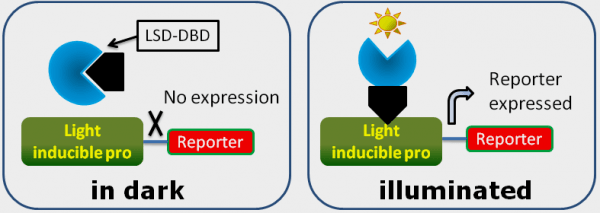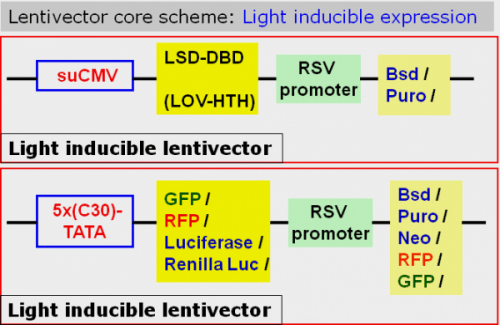Blue light inducible reporter
GenTarget developed a set of reporting lentivirus for Blue light (465 nm) dependent expression. Those reporting lentivirus has a luminescent report or a fluorescent report under the Light-inducible promoter (that contains 5x C30 tandem repeats as the transcriptional response element). This promoter is not active until a light-activator binding to it. The light-activator only binds to light-inducible promoter upon Blue light illumination.
The light-activator is photosensitive protein derived from Erythrobacter litoralis protein EL222[1]. It consists of two domains, the light sensor domain (LSD or called LOV: light-oxygen-voltage) and the DNA binding domain (DBD or called HTH: helix-turn-helix). In the dark, the two domain are interacted with each other to prevent its binding to “light inducible promoter sequence”. When blue light is on (465nm), the illumination breaks these interactions (protein formation changes), opening the DBD domain from LSD domain[2], which triggers the DBD binding to the light-inducible promoter sequence, and turn on the downstream report expression (see mechanism schematic figure below).

The light-inducible promoter that contains the five repeats of light-activator protein’s binding sequence [(C30)x5]. The promoter is not active until the light-activator protein binds to it. And the light-activator protein can bind to it only when there is blue-light illumination, which resulted in the downstream reporter’s expression [1][3].. See the schematic map below for the core structure of the light-inducible reporter lentivectors.

Principle: Cells are double transduced with light-activator lentivirus and light-inducible lentivirus, then, upon the Blue light irradiation, cells will express the luminescent or fluorescent report, which can be easily readout via luciferase assay or by fluorescent microscope. The light-activator lentivirus contains either Puromycin or Blasticidin antibiotic selection marker. The light-inducible reporting lentivirus contains a fluorescent selection marker or an antibiotic selection marker under a constitutive RSV promoter. The different antibiotic resistance allow the selection of the stably infected light-inducible signal reporting cell lines.
Product Features:
- Rapid and nontoxic inducible expression specifically by Blue light illumination, and rapid deactivation in the dark;
- Reversible (induction / deactivation) expression;
- Precisely timed and localized induction;
Those reporting lentivirus products provide the efficient and easy tools to research light-inducible expression mechanism in vitro and in vivo. Click the Product Manual (pdf) for all available products below.
References:
- Biochemistry. 2012 December 18; 51(50): 10024–10034.
- P.N.A.S, 2011 June 7, V(108):9449-9454;
- Nature Chemical Biology, 2014, January 12. 10.1038
- News of The Week, 2015 October 19, V93 (41): 8;